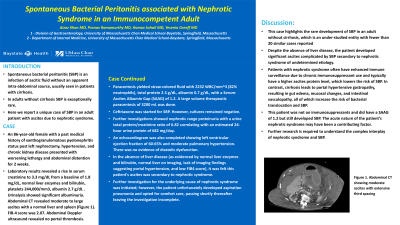Monday Poster Session
Category: Liver
P3111 - A Rare Case of Nephrotic Syndrome Complicated by Spontaneous Bacterial Peritonitis
Monday, October 28, 2024
10:30 AM - 4:00 PM ET
Location: Exhibit Hall E

Has Audio

Aizaz Khan, MD
University of Massachusetts Chan Medical School - Baystate Medical Center
Broad Brook, CT
Presenting Author(s)
Aizaz Khan, MD1, Syed Hamza Sohail, MD2, Pranav S. Ramamurthy, MD3, Yesenia Greeff, MD4
1University of Massachusetts Chan Medical School - Baystate Medical Center, Broad Brook, CT; 2University of Massachusetts Chan Medical School - Baystate Health, Springfield, MA; 3University of Massachusetts Chan Medical School - Baystate Medical Center, Springfield, MA; 4University of Massachusetts Chan Medical School - Baystate Medical Center, Northampton, MA
Introduction: Spontaneous bacterial peritonitis (SBP) is an infection of ascitic fluid without an apparent intra-abdominal source, usually seen in patients with cirrhosis. In adults without cirrhosis, SBP is exceptionally rare. Here we report a unique case of SBP in an adult patient with ascites due to nephrotic syndrome.
Case Description/Methods: An 86-year-old woman presented with worsening lethargy and abdominal distention for 2 weeks. Laboratory results revealed a rise in serum creatinine to 3.3 mg/dL from a baseline of 1.8 mg/dL, normal liver enzymes and bilirubin, platelets 244,000/mm3, albumin 2.7 G/dL . Urinalysis showed significant albuminuria. Abdominal CT revealed moderate to large ascites with a normal liver and spleen. FIB4 score was 2.6. Paracentesis yielded straw-colored fluid with 2232 WBC/mm^3 (82% neutrophils), total protein 2.3 g/dL, albumin 0.7 g/dL, with a Serum-Ascites Albumin Gap (SAAG) of 1.2. The patient started ceftriaxone; however, cultures remained negative. Further investigations showed nephrotic range proteinuria with a urine total protein/creatinine ratio of 6.82 correlating with an estimated 24-hour urine protein of 682 mg/day. She ultimately developed aspiration pneumonia and opted for comfort care, passing shortly thereafter.
Discussion: This case highlights the rare development of SBP in adults without cirrhosis. Despite the absence of liver disease (as evidenced by normal liver enzymes and bilirubin, normal liver on imaging, lack of imaging findings suggesting portal hypertension, and low FIB4 score), the patient developed significant ascites complicated by SBP secondary to nephrotic syndrome of undetermined etiology. The lower incidence of SBP in nephrotic syndrome compared to cirrhosis can be attributed to several factors. Patients with nephrotic syndrome often have enhanced immune surveillance due to chronic immunosuppressant use and typically have a higher ascites protein level, which lowers the risk of SBP. In contrast, cirrhosis leads to portal hypertension and gastropathy, resulting in gut edema, mucosal changes, and intestinal vasculopathy, all of which increase the risk of bacterial translocation and SBP. However, the exact relationship remains unclear, and further research is needed to understand it fully. With fewer than 20 similar cases reported in adults, this case adds valuable insight into the complex interplay of nephrotic syndrome and SBP.
Disclosures:
Aizaz Khan, MD1, Syed Hamza Sohail, MD2, Pranav S. Ramamurthy, MD3, Yesenia Greeff, MD4. P3111 - A Rare Case of Nephrotic Syndrome Complicated by Spontaneous Bacterial Peritonitis, ACG 2024 Annual Scientific Meeting Abstracts. Philadelphia, PA: American College of Gastroenterology.
1University of Massachusetts Chan Medical School - Baystate Medical Center, Broad Brook, CT; 2University of Massachusetts Chan Medical School - Baystate Health, Springfield, MA; 3University of Massachusetts Chan Medical School - Baystate Medical Center, Springfield, MA; 4University of Massachusetts Chan Medical School - Baystate Medical Center, Northampton, MA
Introduction: Spontaneous bacterial peritonitis (SBP) is an infection of ascitic fluid without an apparent intra-abdominal source, usually seen in patients with cirrhosis. In adults without cirrhosis, SBP is exceptionally rare. Here we report a unique case of SBP in an adult patient with ascites due to nephrotic syndrome.
Case Description/Methods: An 86-year-old woman presented with worsening lethargy and abdominal distention for 2 weeks. Laboratory results revealed a rise in serum creatinine to 3.3 mg/dL from a baseline of 1.8 mg/dL, normal liver enzymes and bilirubin, platelets 244,000/mm3, albumin 2.7 G/dL . Urinalysis showed significant albuminuria. Abdominal CT revealed moderate to large ascites with a normal liver and spleen. FIB4 score was 2.6. Paracentesis yielded straw-colored fluid with 2232 WBC/mm^3 (82% neutrophils), total protein 2.3 g/dL, albumin 0.7 g/dL, with a Serum-Ascites Albumin Gap (SAAG) of 1.2. The patient started ceftriaxone; however, cultures remained negative. Further investigations showed nephrotic range proteinuria with a urine total protein/creatinine ratio of 6.82 correlating with an estimated 24-hour urine protein of 682 mg/day. She ultimately developed aspiration pneumonia and opted for comfort care, passing shortly thereafter.
Discussion: This case highlights the rare development of SBP in adults without cirrhosis. Despite the absence of liver disease (as evidenced by normal liver enzymes and bilirubin, normal liver on imaging, lack of imaging findings suggesting portal hypertension, and low FIB4 score), the patient developed significant ascites complicated by SBP secondary to nephrotic syndrome of undetermined etiology. The lower incidence of SBP in nephrotic syndrome compared to cirrhosis can be attributed to several factors. Patients with nephrotic syndrome often have enhanced immune surveillance due to chronic immunosuppressant use and typically have a higher ascites protein level, which lowers the risk of SBP. In contrast, cirrhosis leads to portal hypertension and gastropathy, resulting in gut edema, mucosal changes, and intestinal vasculopathy, all of which increase the risk of bacterial translocation and SBP. However, the exact relationship remains unclear, and further research is needed to understand it fully. With fewer than 20 similar cases reported in adults, this case adds valuable insight into the complex interplay of nephrotic syndrome and SBP.
Disclosures:
Aizaz Khan indicated no relevant financial relationships.
Syed Hamza Sohail indicated no relevant financial relationships.
Pranav Ramamurthy indicated no relevant financial relationships.
Yesenia Greeff indicated no relevant financial relationships.
Aizaz Khan, MD1, Syed Hamza Sohail, MD2, Pranav S. Ramamurthy, MD3, Yesenia Greeff, MD4. P3111 - A Rare Case of Nephrotic Syndrome Complicated by Spontaneous Bacterial Peritonitis, ACG 2024 Annual Scientific Meeting Abstracts. Philadelphia, PA: American College of Gastroenterology.
